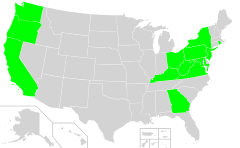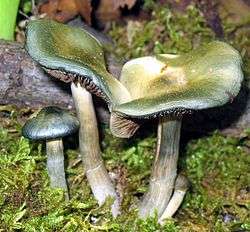Psilocybe ovoideocystidiata
| Psilocybe ovoideocystidiata | |
|---|---|
 | |
| Scientific classification | |
| Kingdom: | Fungi |
| Division: | Basidiomycota |
| Class: | Agaricomycetes |
| Order: | Agaricales |
| Family: | Hymenogastraceae |
| Genus: | Psilocybe |
| Species: | P. ovoideocystidiata |
| Binomial name | |
| Psilocybe ovoideocystidiata Guzmán et Gaines | |
 | |
| Range of Psilocybe ovoideocystidiata | |
| Psilocybe ovoideocystidiata | |
|---|---|
|
| |
| gills on hymenium | |
|
cap is convex or umbonate | |
| hymenium is adnate | |
| stipe is bare | |
|
spore print is blackish-brown to purple | |
| ecology is saprotrophic | |
| edibility: psychoactive | |

Psilocybe ovoideocystidiata is a psilocybin mushroom in the section Stuntzae, having psilocybin and/or psilocin as main active compounds. It is closely related to P. subaeruginascens from Java, P. septentrionalis from Japan, and P. wayanadensis from India. This mushroom was first documented by Richard V. Gaines in Montgomery County, Pennsylvania in June 2003. Although it is sometimes confused with Psilocybe caerulipes, it can be distinguished by its rhomboid spores, larger stature, earlier fruiting season and membranous annulus.
Etymology
From the frequent ovoid both pleuro- and cheilocystidia.
Description
- Cap: 1 — 4.5 cm across, convex to subumbonate, chestnut or orangish brown to yellowish brown to pearly cream color, hygrophanous, glabrous, sub-viscid, translucent-striate near the margin, from slightly to highly undulated in maturity, with irregular yellowish, brownish, or bluish tones, sometimes white when dry. Flesh thick, pliant. Bruises blue and green where injured.
- Gills: adnate attachment and range from whitish to rusty brown, lavender, or dark purple brown.
- Spore print: Dark purple brown.
- Stipe: 1.5 – 9 cm by 1 – 7 mm, equal, somewhat subbulbous, hollow, base sometimes hypogeous, smooth at the top and often having small scales near the bottom, colored whitish with irregular yellowish, brownish, or bluish tones. The partial veil is variable, ranging from a thin cortina that leaves a barely perceptible annular zone, to a substantial membrane that leaves a fairly persistent annulus.
- Taste: farinaceous
- Odor: farinaceous
- Microscopic features: Spores (7–) 8–9 (–12) × ( 5.5 – ) 6 – 7 (–8.5) µm, rhomboid to subrhomboid in face view, subellipsoid in side view, thick-walled, with the wall 0.8 to 1.5 µm thick. One end of the spore has a broad germ pore and the other side has a short hilar appendage. Two types of cheilocystidia and pleurocystidia are present. One type of pleurocystidia measures 16 - 24 x 6 - 8 and is venstricose-rostrate. The other type is larger, 20 - 40 micrometers by 12 - 16 micrometers, globose-pyriform, sometimes with a narrow apex and narrow base. The basidia are 4 spored and measure 20 – 28 × 7 – 9 µm.[1]
Habitat and formation

Psilocybe ovoideocystidiata is common in the Ohio river valley. Often found in the woody debris of overflow areas, along rivers and streams, often in man-made mulch. They are most common from April to mid June but they occasionally fruit as late as November. It was first documented in Pennsylvania, it has been found in Kentucky, Ohio, West Virginia, Virginia, Maryland, the District of Columbia, Delaware, New Jersey, Rhode Island, New York, Washington, Oregon, California and Georgia.
See also
References
- ↑ Guzmán, Gastón; Gaines, Richard V.; Ramírez-Guillén, Florencia (2007). "New Species of Hallucinogenic Psilocybe (Fr.) P. Kumm. (Agaricomycetideae) from the Eastern U.S.A." (PDF). International Journal of Medicinal Mushrooms. 9: 75–77. doi:10.1615/IntJMedMushr.v9.i1.90.
